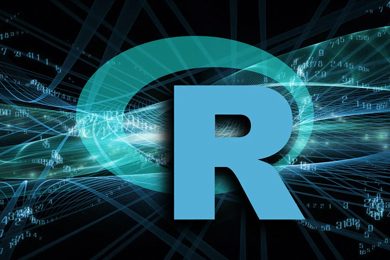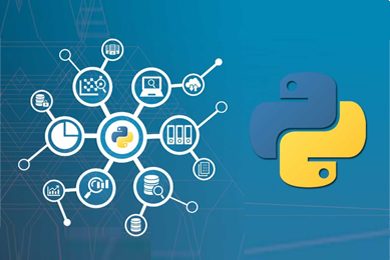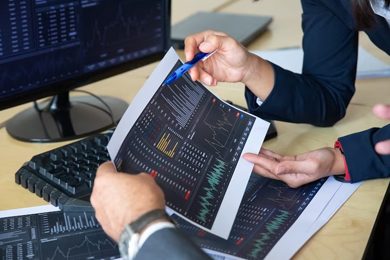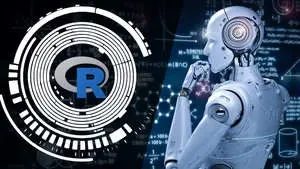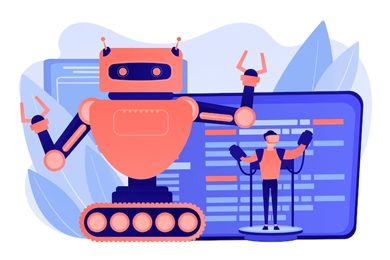This plan includes
- Limited free courses access
- Play & Pause Course Videos
- Video Recorded Lectures
- Learn on Mobile/PC/Tablet
- Quizzes and Real Projects
- Lifetime Course Certificate
- Email & Chat Support
What you'll learn?
- Install R and RStudio and create R script and be able to save your work in R project
- Be able to differentiate between different R data structures such as: string, number, vector, matrix, data frame, factor, date and time object, and many more
- Be able to access elements from R objects, and be able to reshape R objects
- Write R program for executing repetitive tasks using loops and vectorized code
- Write your own user defined functions and create simulations inside R environment
Course Overview
Are you one of the people that would like to start a data science career or are you just fond of using data for data analysis in your spare time or for your job? Do you use spreadsheets for data cleaning, wrangling, visualization, and data analysis? I think it is time to enhance your hobby or your career path with learning adequate skills such as R.
R is s a programming language that enables all essential steps when you are dealing with data like:
-
importing,
-
exporting,
-
cleaning,
-
merging,
-
transforming,
-
analyzing,
-
visualizing,
-
and extracting insights from the data.
Originally R began as a free software environment for statistical computing with graphics supported. Over the years with the rapid development of computing power and the need for tools used for mining and analyzing tons of data that are being generated on every step of our lives, R has emerged into something much greater than its original laid path. Nowadays the R community is vast, every day thousands of people start learning R, and every day new R's libraries are being made and released to the world. These libraries solve different users' needs because they provide different functions for dealing with all kinds of data.
If you are still not convinced to join me on a journey where foundations for your R skills will be laid, please bear with me a bit more. In this R for Beginners course, you will dive into essential aspects of the language that will help you escalate your learning curve. Course first gently touches the basics like:
-
how to install R and how to install R's Integrated Development Environment (IDE) RStudio,
-
then you will learn how to create your first R script and R project folder,
-
R project folder will be your baseline folder where all your scripts and assignments will be saved,
-
you will learn how to install different R packages and how to use functions provided with each package.
After these first steps, you will dive into sections where all major R data structures are presented. You will be able to:
-
differentiate among each data structure,
-
use built-in functions to manipulate data structures,
-
reshape, access elements, and convert R objects,
-
import data from many different sources into R's workspace and
-
export R objects to different data sources.
When you will have a grasp of what R is capable of, a section devoted to programming elements will guide you through essential steps for writing a programming code that can execute repetitive tasks. Here you will master:
-
your first loops,
-
conditional statements,
-
your custom made functions,
-
and you will be able to optimize your code using vectorization.
It is said that a picture can tell an observer a powerful story and holds a stronger message than a thousand words combined. In the final section of this course, the greatest R's power is revealed, the power to tell the story by using data visualization. Here you will master how to build:
-
scatterplots,
-
line charts,
-
histograms,
-
box plots,
-
bar charts,
-
mosaic plots,
-
how to alter R's default graphical parameters to make beautiful figures,
-
and how to export a figure from R to a proper format for further sharing with your colleagues.
If you are still not convinced to start learning R, I will share with you how the course is structured:
-
Each section holds separate exercises covering learning material that is related to the section's topic.
-
Normally each exercise begins with a short intro that provides a basic understanding of the topic, then a coding exercise is presented.
-
During coding exercise, you will write the R code for executing given tasks.
-
At the end of each section, an assignment is presented.
-
Each assignment tests the skills you have learned during a given section.
-
In the last two assignments, you will write a code to build a simulation environment where you will execute the simulation and present the results with proper visualization techniques.
Do not lose more time and please enroll in the course today. I guarantee you will learn a lot and you will enjoy the learning process.
Pre-requisites
- No prior knowledge is required. You need only a desire to learn new things and an access to a computer.
Target Audience
- Anyone whose hobby or career is related to data analysis
- Data science or statistics enthusiasts
- Anyone who does data analysis with spreadsheets and would like to enhance his skills and deliverance
- Anyone with a desire to learn a new programming language for statistics and data science
- Business analyst and researchers who would like to enhance skills of data visualization
- Beginner R developers starting career in data science
Curriculum 78 Lectures 13:26:19
Section 1 : Getting Started
- Lecture 2 :
- Install R and RStudio
- Lecture 3 :
- RStudio
- Lecture 4 :
- R basics
- Lecture 5 :
- Basic mathematical operations
- Lecture 6 :
- R scripts and RStudio projects
- Lecture 7 :
- R packages
- Lecture 8 :
- Basic built-in functions
- Lecture 9 :
- Save and load workspace
- Lecture 10 :
- Section summary and assignment 1
Section 2 : Basic R Data Structures
- Lecture 1 :
- Integers
- Lecture 2 :
- Doubles
- Lecture 3 :
- Complex numbers
- Lecture 4 :
- Logicals
- Lecture 5 :
- Strings introduction
- Lecture 6 :
- Strings manipulation
- Lecture 7 :
- Strings matching, replacement and regular expressions (part 1)
- Lecture 8 :
- Strings matching, replacement and regular expressions (part 2)
- Lecture 9 :
- Special R values and data type conversion
- Lecture 10 :
- Section summary and assignment 2
- Lecture 11 :
- Assignment 2 walk-through
- Lecture 12 :
- Section intro
Section 3 : Multidimensional R Data Structures
- Lecture 1 :
- Section intro
- Lecture 2 :
- Vectors - part 1
- Lecture 3 :
- Vectors - part 2
- Lecture 4 :
- Matrices - part 1
- Lecture 5 :
- Matrices - part 2
- Lecture 6 :
- Arrays - part 1
- Lecture 7 :
- Arrays - part 2
- Lecture 8 :
- Lists - part 1
- Lecture 9 :
- Lists - part 2
- Lecture 10 :
- Section summary and assignment 3
- Lecture 11 :
- Assignment 3 walk-through - part 1
- Lecture 12 :
- Assignment 3 walk-through - part 2
Section 4 : Special R data structures & dealing with import / export
- Lecture 1 :
- Section intro
- Lecture 2 :
- Factors - part 1
- Lecture 3 :
- Factors - part 2
- Lecture 4 :
- Date and time - part 1
- Lecture 5 :
- Date and time - part 2
- Lecture 6 :
- Data frames - part 1
- Lecture 7 :
- Data frames - part 2
- Lecture 8 :
- Import data from a file - part 1
- Lecture 9 :
- Import data from a file - part 2
- Lecture 10 :
- Export data to a file - part 1
- Lecture 11 :
- Export data to a file - part 2
- Lecture 12 :
- Section summary and assignment 4
- Lecture 13 :
- Assignment 4 walk-through
Section 5 : Programming with R
- Lecture 1 :
- Section intro
- Lecture 2 :
- Logical statements - part 1
- Lecture 3 :
- Logical statements - part 2
- Lecture 4 :
- for loop - part 1
- Lecture 5 :
- for loop - part 2
- Lecture 6 :
- next & break statement - part 1
- Lecture 7 :
- next & break statement - part 2
- Lecture 8 :
- while loop - part 1
- Lecture 9 :
- while loop - part 2
- Lecture 10 :
- Nested loops - part 1
- Lecture 11 :
- Nested loops - part 2
- Lecture 12 :
- User defined functions - part 1
- Lecture 13 :
- User defined functions - part 2
- Lecture 14 :
- Vectorized code - part 1
- Lecture 15 :
- Vectorized code - part 2
- Lecture 16 :
- Section summary and assignment 5
- Lecture 17 :
- Assignment 5 walk-through
Section 6 : Visualize data with R base graphics
- Lecture 1 :
- Section intro
- Lecture 2 :
- Scatter plots
- Lecture 3 :
- Line charts
- Lecture 4 :
- Histograms & density plots
- Lecture 5 :
- Box plots
- Lecture 6 :
- Bar charts
- Lecture 7 :
- Mosaic plots
- Lecture 8 :
- Graphical parameters - part 1
- Lecture 9 :
- Graphical parameters - part 2
- Lecture 10 :
- Multi-plots
- Lecture 11 :
- Section summary and assignment 6
- Lecture 12 :
- Assignment 6 walk-through - part 1
- Lecture 13 :
- Assignment 6 walk-through - part 2
- Lecture 14 :
- Assignment 6 walk-through - part 3
Our learners work at
Frequently Asked Questions
How do i access the course after purchase?
It's simple. When you sign up, you'll immediately have unlimited viewing of thousands of expert courses, paths to guide your learning, tools to measure your skills and hands-on resources like exercise files. There’s no limit on what you can learn and you can cancel at any time.Are these video based online self-learning courses?
Yes. All of the courses comes with online video based lectures created by certified instructors. Instructors have crafted these courses with a blend of high quality interactive videos, lectures, quizzes & real world projects to give you an indepth knowledge about the topic.Can i play & pause the course as per my convenience?
Yes absolutely & thats one of the advantage of self-paced courses. You can anytime pause or resume the course & come back & forth from one lecture to another lecture, play the videos mulitple times & so on.How do i contact the instructor for any doubts or questions?
Most of these courses have general questions & answers already covered within the course lectures. However, if you need any further help from the instructor, you can use the inbuilt Chat with Instructor option to send a message to an instructor & they will reply you within 24 hours. You can ask as many questions as you want.Do i need a pc to access the course or can i do it on mobile & tablet as well?
Brilliant question? Isn't it? You can access the courses on any device like PC, Mobile, Tablet & even on a smart tv. For mobile & a tablet you can download the Learnfly android or an iOS app. If mobile app is not available in your country, you can access the course directly by visting our website, its fully mobile friendly.Do i get any certificate for the courses?
Yes. Once you complete any course on our platform along with provided assessments by the instructor, you will be eligble to get certificate of course completion.
For how long can i access my course on the platform?
You require an active subscription to access courses on our platform. If your subscription is active, you can access any course on our platform with no restrictions.Is there any free trial?
Currently, we do not offer any free trial.Can i cancel anytime?
Yes, you can cancel your subscription at any time. Your subscription will auto-renew until you cancel, but why would you want to?
Instructor

84155 Course Views
1 Courses



 Tech & IT
Tech & IT
 Business
Business
 Coding & Developer
Coding & Developer
 Finance & Accounting
Finance & Accounting
 Academics
Academics
 Office Applications
Office Applications
 Art & Design
Art & Design
 Marketing
Marketing
 Health & Wellness
Health & Wellness
 Sounds & Music
Sounds & Music
 Lifestyle
Lifestyle
 Photography
Photography




